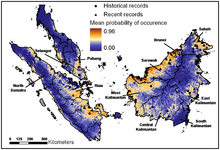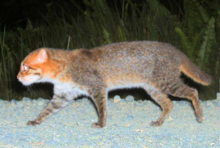Flat-headed cat: Difference between revisions
Extended confirmed users, Pending changes reviewers 53,965 edits →Distribution and habitat: edited ref |
Extended confirmed users, Pending changes reviewers 53,965 edits →Conservation: moved some info to new section →Threats: extended with ref |
||
| Line 45: | Line 45: | ||
Overall, however, little is known about its wild behavior,<ref name=southeast/> but a [[gestation period]] of about 56 days, and a [[Litter (animal)|litter]] size of 1-2 kittens have been reported in captivity.<ref name=arkive>ARKive: [http://www.arkive.org/species/GES/mammals/Prionailurus_planiceps/ Flat-headed cat (Prionailurus planiceps)]. Accessed 2008-04-04</ref> Captive individuals have lived for fourteen years.<ref name=catgroup/> |
Overall, however, little is known about its wild behavior,<ref name=southeast/> but a [[gestation period]] of about 56 days, and a [[Litter (animal)|litter]] size of 1-2 kittens have been reported in captivity.<ref name=arkive>ARKive: [http://www.arkive.org/species/GES/mammals/Prionailurus_planiceps/ Flat-headed cat (Prionailurus planiceps)]. Accessed 2008-04-04</ref> Captive individuals have lived for fourteen years.<ref name=catgroup/> |
||
== |
== Threats == |
||
Flat-headed cats are primarily threatened by wetland and lowland forest destruction and [[degradation]].<ref name=catgroup/> Causes of this destruction include human settlement, forest transformation to [[plantation]]s, draining for [[agriculture]], [[pollution]], and excessive hunting, wood-cutting and [[fishing]]. In addition, clearance of coastal [[mangrove]]s over the past decade has been rapid in tropical Asia. The depletion of fish stocks from over-fishing is prevalent in many Asian wetland environments and is likely to be a significant threat. Expansion of [[oil palm]] plantations is currently viewed as the most urgent threat.<ref name=iucn/> |
|||
The Flat-headed Cat is considered [[Endangered species|endangered]] by the [[IUCN]] and listed on appendix 1 by [[CITES]]. The total population is likely below 2500 adults with no single sub-population containing more than 250 adults.<ref name=iucn/> While habitat loss and [[water pollution]] are serious threats, sightings from [[oil palm]] plantations suggests it is less specialized than generally believed.<ref name=catgroup/> The Flat-headed Cat is fully protected throughout its natural range, except in Brunei, where this species lacks legal protection.<ref name=arkive/> Sightings are generally very rare.<ref name=walker/> |
|||
They are also threatened by [[trapping]], [[snaring]] and [[poison]]ing.<ref name=WCoW/> They have been captured in traps set out to protect domestic fowl.<ref name=catgroup/> |
|||
==Conservation== |
|||
The flat-headed cat is included on [[CITES Appendix I]].<ref name=iucn/> The felid is fully protected by national legislation over its range, with hunting and trade prohibited in Indonesia, Malaysia, and Thailand.<ref name=catgroup/> |
|||
==References== |
==References== |
||
Revision as of 20:35, 13 October 2011
| Flat-headed Cat[1] | |
|---|---|

| |
| Scientific classification | |
| Kingdom: | |
| Phylum: | |
| Class: | |
| Order: | |
| Family: | |
| Genus: | |
| Species: | P. planiceps
|
| Binomial name | |
| Prionailurus planiceps | |

| |
| Range of Flat-headed Cat[3] | |
The Flat-headed Cat (Prionailurus planiceps) is a small wild
This cat is very rare in captivity, with less than 10 individuals – all in
Charactersitics
The flat-headed cat has a thick fur that is generally dark reddish-brown tinged grey, with a more reddish head and whitish underparts. Except for the relatively faint facial streaks, it is rather unpatterned. The legs are fairly short, and the ears are short and round. Its name comes from its flattened head.[6] It has a head-and-body length of 41 to 50 cm (16 to 20 in) and a short tail of 13 to 15 cm (5.1 to 5.9 in).[5] It weighs 1.5 to 2.5 kg (3.3 to 5.5 lb).[7]
The inter-digital webs on its paws help the cat gain better traction in muddy environments and water, and are even more pronounced on this cat than those on the paws of the
Distribution and habitat

The distribution of flat-headed cats is restricted to lowland
Flat-headed cats occur in both
Ecology and behavior
The Flat-headed Cat is generally considered a
It has relatively long
In the wild, flat-headed cats are solitary, and
Overall, however, little is known about its wild behavior,
Threats
Flat-headed cats are primarily threatened by wetland and lowland forest destruction and
They are also threatened by
Conservation
The flat-headed cat is included on
References
- ^ OCLC 62265494.
- ^ a b c d Template:IUCN
- ^
- ^ International Species Information System. Captive Prionailurus planiceps. Accessed 2010-04-16
- ^ a b c Nowak, R. (editor) 1999. Walker's Mammals of the World. 6th edition. ISBN 0-8018-5789-9
- ^ ISBN 0-226-77999-8.)
{{cite book}}: CS1 maint: multiple names: authors list (link - ^ a b Francis, C. (2001) A Photographic Guide to Mammals of South-east Asia including Thailand, Malaysia, Singapore, Myanmar, Laos, Cambodia, Vietnam, Java, Sumatra, Bali and Borneo. ISBN 85974 507 5
- ^ a b c d e f g Nowell, K., Jackson, P. (1996) Flat-headed Cat. Prionailurus planiceps. In: Wild Cats: status survey and conservation action plan. IUCN/SSC Cat Specialist Group, Gland, Switzerland.
- ^ Payne, J., Françis, C. M., Phillipps, K. (1998) A Field Guide to the Mammals of Borneo. Sabah Society. 3rd reprint, ISBN 967-99947-1-6
- ^ a b ARKive: Flat-headed cat (Prionailurus planiceps). Accessed 2008-04-04

